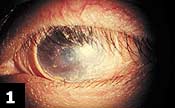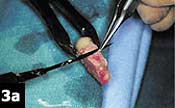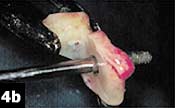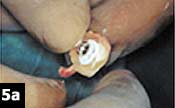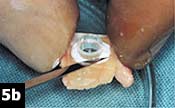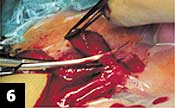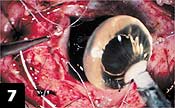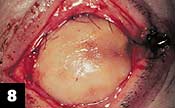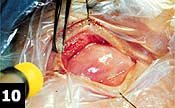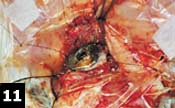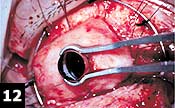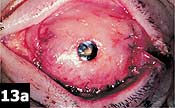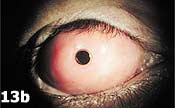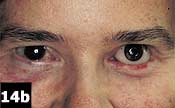Radical procedure can restore vision in patients with corneal damage
The implant is formed by a central PMMA optic cylinder fixed in a rectangular haptic made from the patient’s own dental lamina.
SALZBURG, Austria – A radical corneal prosthesis surgery can restore sight in patients blinded by severe corneal problems. The osteo-odonto-keratoprosthesis (OOKP), a precorneal fixed visual aid made from the patient’s own dental bone, can still be a viable option for selected patients, according to Günther Grabner, MD, of Salzburg Eye Clinic here.
|
Speaking here at the winter meeting of the European Society of Cataract and Refractive Surgeons, Prof. Grabner said the technique was first introduced in Italy in 1963 by Strampelli and is now known and used by only a few surgeons worldwide.
“It is a long, complicated and de manding procedure, which has frequent complications. Patients need a life-long close follow-up. However, there have been quite a few desperate cases for whom this technique was the last resort, and it has worked,” he said.
| ||||||
The procedure is in fact limited to extreme cases of bilaterally blind patients (visual acuity less than 1/200 and up to 20/200) who have lost vision through corneal causes.
“When I say last resort, I really mean that in these patients penetrating keratoplasty or even the newest types of artificial corneal implants have no chance of success,” Prof. Grabner said.
A healthy, fully attached retina is an indispensable condition for the operation, as are “normal” IOP levels, some degree of light and color vision and sufficiently healthy teeth. Donor teeth have been tried, but the chances of success are very slight, even with immunosuppression.
A long preparation
The OOKP is designed to give a new optical window to the eye. It is formed by a central PMMA optic cylinder fixed at the center of a rectangular haptic made from the dentin, bone and periosteum lamina.
|
“The lamina is prepared through a complicated procedure starting with the extraction of a tooth from the same patient,” Prof. Grabner explained. “The tooth is then cut vertically and transversally in sections, one of which, shaped and ground, becomes the haptic of the prosthesis. A hole is drilled in the center, and the optic cylinder is fixed into it and glued to the dentin.”
This preparation alone takes a few hours and requires patient, expert hands, he said.
The prosthesis is first implanted under the lower lid of the other eye and stored there for 2 to 3 months to be revitalized. Meanwhile, a small portion of the same patient’s buccal mucosa is taken and the recipient eye is prepared by removing the iris and the lens and by performing an anterior vitrectomy. The buccal mucosa membrane is then sutured onto the anterior surface of the eye to cover the entire corneal area.
“At the end of this step, after about 4 to 8 hours of surgery, the recipient eye is patched with buccal mucosa while the lamina is resting in the other eye, under the skin. The patient will then have to wait 3 months before the second step of the procedure can be performed,” Prof. Grabner said.
| ||||||
Implanting the lamina
At the end of the 3-month period, the lamina is removed from the lower lid. The buccal mucosa is lifted and a trephination of 3.8-mm to 4.2-mm diameter is made in the center of the cornea.
“This hole will receive the posterior part of the optic cylinder when the lamina is sutured to the cornea,” Prof. Grabner said. The suturing must be done with rapid maneuvers to prevent excess bleeding, he added.
The buccal mucosa is then replaced over the implant after a central hole of 3 mm has been created to leave the optic uncovered.
“Alternatively, the eyelid can be used in place of the buccal membrane at this stage, with the optic of the implant slightly protruding through a hole made in the center of it,” he said.
After the implant has stabilized, some cosmetic enhancements are possible. To attenuate disturbance from bright light, a removable sunglass shield can be fitted onto the optic.
Long-term results
Long-term results of this implant come principally from Italy, where Giancarlo Falcinelli, MD, a direct pupil of Prof. Strampelli, has carried out and documented more than 220 cases, with mean follow-up of more than 7 years.
“The longest one is 25 years. The implant is stable and the patient sees well,” Prof. Grabner said.
|
In 83% of these 220 cases, visual acuity is 20/100 or better, and in 65% of cases is between 20/25 and 20/20.
Prof. Grabner also presented his series of 18 implants, most of them transpalpebral.
“We lost two of these eyes with glaucoma, two with ulcerations and two in children who were implanted with a donor lamina from father and mother respectively,” he said.
He found that complications are frequent and occur mainly in the long term, about 12 months after implant-ation.
“We had quite a high rate of glaucoma, some cases of ulceration, necrosis of the tooth and hypotony,” he said. “Retinal detachment is quite a rare event. Prof. Falcinelli removes the optic cylinder, treats the retina and puts the cylinder back after a couple of months.”
In the two children the lamina was almost completely dissolved within 2 months.
“Since it happened in both children, we have reasons to suppose that the turnover of the bone cells is too high in children, and as a result the tooth is rapidly dissolved. They are therefore not good cases for osteo-odonto-keratoprosthesis,” Prof. Grabner said.
|
What’s new in OOKP?
At present, there are only five surgeons in Europe using the osteo-odonto-keratoprosthesis.
“We periodically meet, exchange our experiences and discuss new developments of the technique,” Prof. Grabner said.
“We are now monitoring our implants with spiral CT scan at regular intervals to observe the state of the bone during the follow-up. I personally used spiral CT scan in nine cases. Some degree of reduction of the lamina was observed in all patients, but in eight of them there was no loss of stability and integrity of the lamina-cylinder complex. One patient lost the inferior part of the lamina, which had to be removed.”
| ||||
No correlation between degree of reduction of the lamina and age, diagnosis, follow-up time and method of coverage of the lamina (buccal mucosa/palpebral skin) was found.
Another common strategy is that of performing glaucoma implants (Baerveldt and Ahmed) at the same time as OOKP.
“We do it in selected cases, and it seems to work quite well,” Prof. Grabner said.
A new optic, shorter, oval and with a larger visual field has also been devised by Prof. Falcinelli.
“Through the new optic cylinder, vitreous and retina are more visible. In case of retinal detachment, you can now do a vitrectomy and reattach the retina without removing the device,” Prof. Grabner said.
| ||||
For Your Information:
- Günther Grabner, MD, can be reached at St. Johanns-Spital, Muellner Hauptstrasse 48, A-5020 Salzburg, Austria; (43) 662-4482-3701; fax: (43) 662-4482-3724; e-mail: g.grabner@lks.at.
- Giancarlo Falcinelli, MD, can be reached at Via dall’Ongaro 53, 00153 Rome, Italy; (39) 06-580-9994; fax: (39) 06-588-5541; e-mail: falcinellig@tiscalinet.it.

